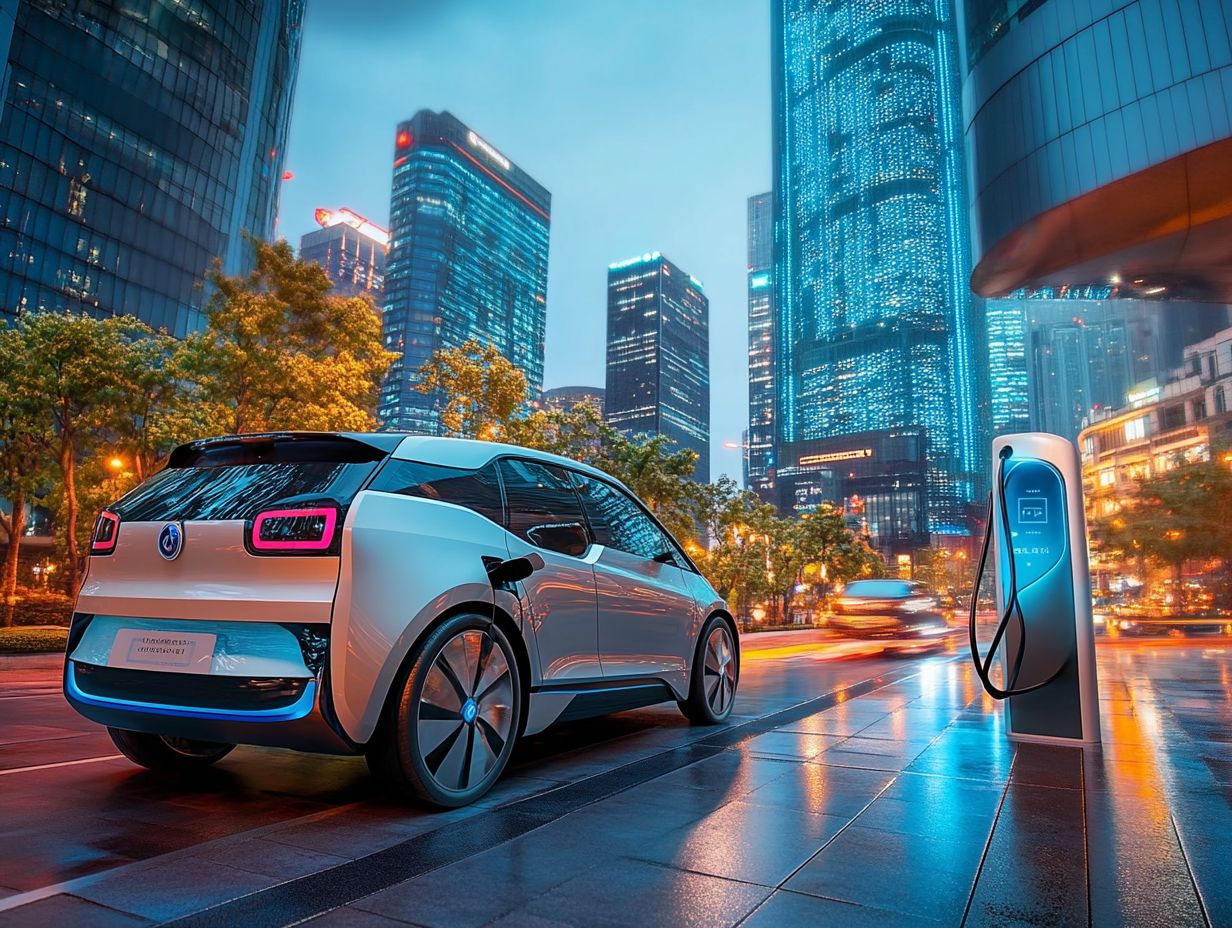EV Market Predictions for the Next 5 Years
The electric vehicle (EV) market is revolutionizing the automotive landscape, propelled by technological advancements, evolving consumer preferences, and robust government backing.
This overview delves into the current state of the EV market. We will examine the key factors driving its growth and profile the leading manufacturers that are shaping the industry.
Get ready to uncover predictions for the next five years, identify challenges and opportunities, and explore what all of this means for the future of transportation!
Contents
- Key Takeaways:
- Exploring the Thriving Electric Vehicle Market Today!
- Factors Influencing the EV Market
- Top Players in the EV Market
- Predictions for the Next 5 Years
- Challenges and Opportunities for the EV Market
- Frequently Asked Questions
- What are some current trends in the EV market?
- What is the predicted growth rate for the EV market in the next 5 years?
- How will government policies and regulations impact the EV market in the next 5 years?
- What challenges will the EV market face in the next 5 years?
- Which regions will likely lead the EV market in the next 5 years?
- How will new EV technology shape the market in the next 5 years?
Key Takeaways:

The EV market is set to soar in the next five years, driven by government policies and advancements in technology.
Leading manufacturers and models will play a pivotal role in shaping the EV market, focusing on expanding their market share.
The success of the EV market will hinge on addressing challenges like infrastructure and charging concerns, alongside changing consumer perceptions toward EV adoption.
Exploring the Thriving Electric Vehicle Market Today!
The global electric vehicle (EV) market has rapidly transformed over the past decade. Powerhouses like China, the USA, and European nations such as Norway and the Netherlands are leading the way. This shift stems from a significant rise in electric vehicle adoption, fueled by government policies designed to cut CO2 emissions and promote sustainable practices.
The environmental impact of these initiatives is major; everyone automotive manufacturers, consumers, and beyond is playing a role in crafting a cleaner, greener future.
With robust growth forecasts signaling ongoing market expansion, sales data reveals a notable surge across multiple segments, including battery electric vehicles (BEVs), plug-in hybrid electric vehicles (PHEVs), and electric trucks.
Current State and Growth Projections
The current state of the EV market suggests a remarkable transformation in consumer preferences. Electric vehicles are gaining traction due to advancements in charging infrastructure and battery technology.
Recent statistics show that electric vehicles now represent approximately 6% of total vehicle sales an impressive jump from previous years. Industry experts anticipate this figure to rise to 20% by 2028, driven by a growing consumer appetite for sustainable transportation solutions.
As automakers expand their electric offerings, the proliferation of charging stations will be essential in catalyzing this growth. Enhanced access to charging facilities not only alleviates the fear of running out of battery before reaching a charging station but also encourages more consumers like you to make the switch to EVs. This sets a promising trajectory for the market in the years ahead.
Factors Influencing the EV Market
Several key factors are propelling the evolution of the electric vehicle market. Supportive government policies are playing a significant role alongside rapid advancements in electric vehicle technology and the expansion of charging infrastructure.
Government Policies and Incentives
Government policies are instrumental in shaping the electric vehicle (EV) market. They provide a range of incentives designed to encourage your adoption of electric vehicles while simultaneously reducing CO2 emissions.
These incentives include enticing tax breaks and rebates for those purchasing electric vehicles, as well as funding aimed at expanding charging infrastructure. Take Norway, for instance; it has experienced remarkable success, with over half of new car sales being electric. This achievement is largely attributed to generous financial incentives and access to toll exemptions.
Similarly, Sweden has established a robust subsidy system paired with a comprehensive charging network, resulting in a substantial uptick in electric vehicle sales.
Such initiatives not only advocate for cleaner transportation solutions but also cultivate a mindset of sustainability, inspiring other nations to adopt similar measures and weave them into their regulatory frameworks.
Advancements in Technology

Advancements in electric vehicle technology play a vital role in the expansion of the EV market. They emphasize improvements in battery production, recycling methods, and the development of smart charging solutions.
These innovations boost the efficiency and lifespan of electric vehicles. They also tackle larger environmental issues related to battery waste. As awareness grows around sustainable resource management, battery recycling initiatives are gaining momentum. This allows you to recover valuable materials while minimizing your ecological footprint.
Smart charging technologies are changing how you use your electric vehicle. They help you save money and use energy more effectively. This seamless integration of technology enhances your experience and aligns with global initiatives aimed at promoting environmentally responsible practices in the automotive sector.
Top Players in the EV Market
The EV market boasts a diverse array of key players, ranging from established automotive giants to emerging startups. Each competes for market share with groundbreaking electric vehicle models and cutting-edge battery technologies.
Leading Manufacturers and Models
Leading manufacturers in the electric vehicle sector have introduced a captivating array of models. These are tailored to various segments within the EV markets of the USA and China.
These companies focus on crafting vehicles with impressive ranges and advanced technology. They are also fine-tuning their strategies to meet local demands. For instance, in the USA, one prominent player emphasizes sustainable luxury, presenting high-performance models that appeal to affluent consumers. Meanwhile, in China, another leading brand prioritizes affordability and practicality, aiming to capture a wider audience.
This competitive landscape is vividly illustrated by sales figures. Some manufacturers boast exponential growth year after year, while others integrate smart features and advanced battery technology. This creates a fascinating comparison of their offerings as they respond to ever-evolving consumer preferences.
Predictions for the Next 5 Years
Predictions for the next five years indicate substantial growth in electric vehicle (EV) sales, driven by rising consumer demand and advancements in electric mobility and charging solutions. For a deeper insight, check out the global EV sales trends expected by 2025.
Sales and market share projections reveal that electric vehicles will capture a substantial slice of the automotive market over the next five years. This growth is driven by favorable market conditions.
With consumer demand for sustainable alternatives on the rise and advancements in battery technology making waves, regions like North America and Europe are set to take the lead. They showcase remarkable sales growth. Simultaneously, emerging markets in Asia are gaining momentum, creating a diverse landscape that challenges traditional automotive paradigms. This shift inspires manufacturers to innovate and encourages you to rethink your mobility choices.
If you prioritize eco-friendly options, you’ll enjoy exciting benefits such as incentives and potentially lower long-term operating costs. This further solidifies your transition toward electric mobility.
Impact on the Automotive Industry

The rise of electric vehicles is transforming the automotive industry. Consumers are increasingly leaning towards electric mobility, which significantly cuts CO2 emissions.
This shift pushes manufacturers to rethink how they produce cars. They are focusing more on sustainability and efficiency in their supply chains.
With growing demand for eco-friendly options, automakers are investing heavily in research and development for advanced battery technologies and lightweight materials. These innovations enhance the performance and range of electric vehicles and spark competition, prompting traditional car makers to embrace electrification.
As the industry adapts, collaboration between tech firms and automakers becomes vital. This partnership creates a dynamic landscape where innovation thrives.
Challenges and Opportunities for the EV Market
The electric vehicle market is navigating a complex landscape filled with challenges and opportunities.
Key tasks include developing a robust charging infrastructure and reshaping consumer perceptions about electric mobility. These elements are crucial for fostering growth and acceptance in the EV sector.
Infrastructure and Charging Concerns
Infrastructure and charging concerns are essential for expanding the EV market. The availability of public charging stations and fast chargers directly influences consumer adoption.
As technology improves, charging stations are becoming more accessible and efficient. This shift is changing attitudes toward electric vehicles. Enhanced networks of rapid chargers mean quicker refueling times, alleviating range anxiety.
Strategic partnerships between automakers and charging networks, along with government incentives to expand infrastructure, boost confidence among potential buyers. This evolving landscape addresses initial hesitations and stimulates increased sales in the electric vehicle market.
Consumer Perceptions and Adoption
Consumer perceptions of electric vehicles play a pivotal role in adoption rates. Factors like the availability of used electric cars and the variety of EV models influence these perceptions.
Understanding how potential buyers view electric vehicles is essential. Concerns about charging infrastructure, battery life, and resale value can either deter or encourage purchasing decisions.
This emphasizes the need for manufacturers to invest in public awareness campaigns and technological advancements. Policymakers must establish supportive regulations and incentives. Together, these efforts can cultivate a more favorable perspective on electric mobility, ultimately boosting consumer confidence and growth in the EV sector.
Frequently Asked Questions
What are some current trends in the EV market?

Current trends in the EV market include rising consumer demand, government incentives, and advancements in technology and infrastructure.
What is the predicted growth rate for the EV market in the next 5 years?
The EV market is expected to grow at a compound annual growth rate of over 20% in the next 5 years, reaching a market size of over 10 million units by 2025.
How will government policies and regulations impact the EV market in the next 5 years?
Government policies, such as stricter emission standards and incentives for EV purchases, are anticipated to drive growth in the EV market over the next 5 years.
What challenges will the EV market face in the next 5 years?
The EV market faces several challenges. These include limited charging infrastructure and higher costs compared to traditional vehicles.
Which regions will likely lead the EV market in the next 5 years?
Asia Pacific is set to lead the EV market. Countries like China and Japan show high demand and strong government support for eco-friendly transport.
How will new EV technology shape the market in the next 5 years?
New technology is improving EVs. With longer battery life and faster charging, EVs will become more practical and appealing to consumers.






